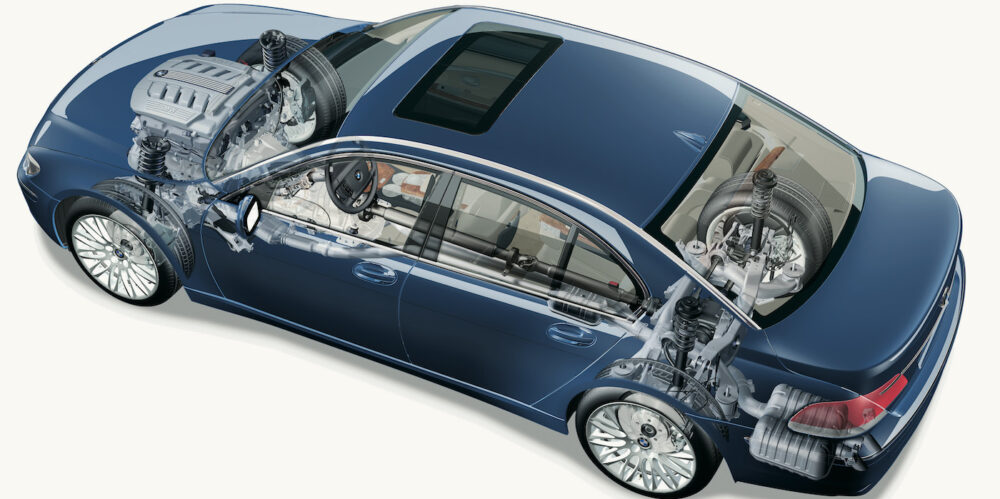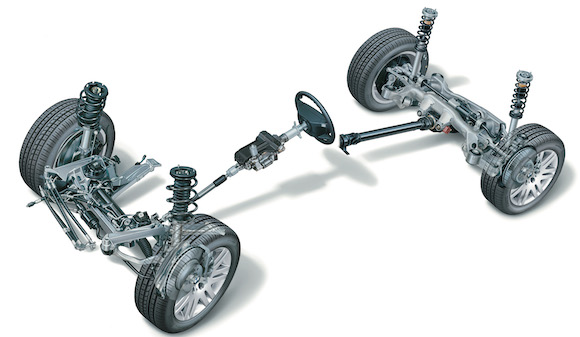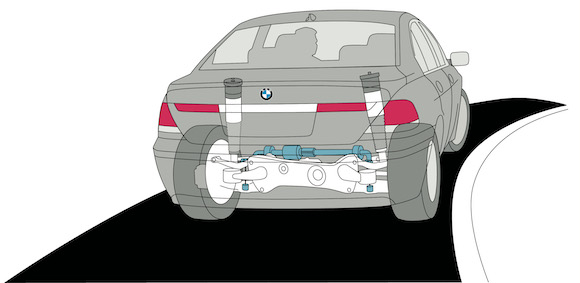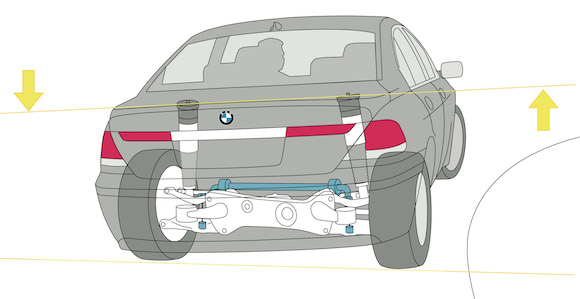For the BMW 7 Series E65/E66 manufactured between 2001-’08, engineers went with an innovative rear ride control system. The Dynamic Drive system that uses active anti-roll bars to keep the vehicle level was standard on these models. Some of these vehicles have optional Electronic Dampener Control (EDC) that tunes the compression and rebound of the dampener to the movement of the wheels and body for the best possible ride.
All E65 and E66 models have the Dynamic Drive system working with the air ride system to level the vehicle. The system uses two active anti-roll bars that are hydraulically controlled. It is an infinitely variable anti-roll bar that can push back. This allows for better wheel travel on bumpy roads and better body control in the corners without the disadvantages of an anti-roll bar that’s too thick or too thin.
The Dynamic Drive control module uses the input signals from the height sensor, accelerometers mounted near the suspension towers, and a range of other sensors to control the hydraulic motors on the bars. The hydraulic system also has sensors to manage the pressure and valves.
From a diagnostic perspective, there is not much that can go wrong on the mechanical side. However, the electronic side is another matter. This system uses a lot of bandwidth on the CAN bus. Later models moved the Dynamic Drive and Electronic Dampener Control systems to a Flex Ray serial data bus. If you see a large number of communication codes in other models, this could impact the operation of the ride control system due to loss of information that the system needs to operate.
On higher-mileage E65/E66 models, the compressor will wear out before the air shocks. If you are pulling codes for compressor or reservoir plausibility errors or codes that say the compressor timed out, it could be time for a new compressor. If an air shock has been damaged and the vehicle has high miles, the best practice would be to replace both units and the compressor.
Modes and Filters
The task of the BMW Dynamic suspension is to control ride height at the rear axle back to the target level if the load or cornering dynamics change. The system works by feeding air in or extracting air out of the air bladders and changing hydraulic pressure at the roll bar. The height sensors provide the control module with information on vehicle height. If heights are outside of the specified tolerances, the system intervenes using the air supply to trim the vehicle for a given mode or condition.
Most of the changes to the load take place when the vehicle is at a standstill before or after a drive. The system wakes itself up when the doors or trunk are opened and switches off 16 minutes after the vehicle has been parked.
In order to distinguish load changes from other disturbances, such as road irregularities, the control modules filter the height signals. The modules use inputs like wheel speed and lateral/vertical accelerometer data to verify the condition of the vehicle.
The system will shift between modes as conditions change. These changes also include changes in key and vehicle security.
System Modes
The air ride system on the BMW 7 Series has 10 modes for the suspension. Two of the 10 modes are used by the factory and dealership for transport and manufacturing. The remaining eight modes are used by the system to trim under various conditions.
Sleep: This mode is the initial state for interventions. No changes in ride height take place.
Pre: In this mode, the load-cutout message of the power module initiates a time-controlled pre-run and after-run trim of the vehicle. The load-cutout signal is set by activities on the vehicle, such as pressing the door handle or operating the central locking system and output on the K-CAN data bus. If the vehicle is parked, the load-cutout signal remains set for approximately 16 minutes after the last action.
Post: Used to balance out any visual inclination before entering sleep mode. The intervention takes place within a narrow tolerance range of 7 mm.
Normal: The starting point for the normal operating status with the engine running. The fast filter is used with a narrow tolerance range of around 10 mm. It is a narrower tolerance range than Pre mode and can be used because the alternator is working.
Drive: Activated when the wheel speed sensor starts to detect movement. This mode is used when the car is moving and can be used to level the vehicle as fuel is consumed.
Curve: Used to trim the vehicle in corners to keep the vehicle stable. It uses inputs from the height, steering angle and yaw/accelerometer cluster. Curve mode will add pressure to the outside wheels to level the vehicle. This mode quickly switches in and out of drive mode.
Kerb: Detects if the vehicle is parked with one or two wheels on an obstacle such as a curb, or if there is a wheel in a gutter. This prevents the vehicle from driving off with the suspension at uneven ride heights if the vehicle tries to self-level. This mode activates both the left and right sides if the difference is greater than 24 mm.
Lift: Activates if the vehicle is lifted or jacked up in the shop. This mode is looking for suspension rebound that’s greater than 55 mm. The vehicle will rise slightly and stop other modes that may make the vehicle unstable if the customer is changing the tire. The mode typically deactivates when the system detects forward vehicle movement.


















